
A photo I snapped on the subway. For some reason, subways lend themselves well to photography.

That big mountain is bongnaesan rising out of the urban sea of Young-do island, where I live. I live on the other side of bongnaesong. Notice to two bridges in the bottom of the photo. The orange one was built by the Japanese, I have been told.

A grandfather and his granddaughter at Beomosa. There is nothing quite as satisfying to photograph as an honest smile.

One of the math teachers, Su-jin, had her 28th birthday party at ESS. One difference between her birthday and mine: After she blew out the candles another teacher quickly re-packaged the cake so she could take it home. After I blew out MY candles the other teachers decended on it like vultures to a crippled animal.

Cups lit by the cold winter light at Beomosa.

The pride of Busan: The Gwangali Bridge.

The view from 394 meters up the Hamjigren side of Bongnaesan.

It's my favorite time of year.

Gavin found this bottle of snakeoil at a knickknack shop in Nampo-dong.
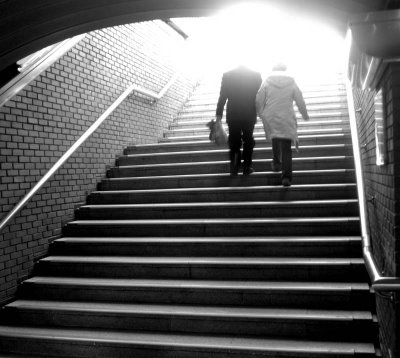
A frame I thought was a dud turned into a keeper with the help of good ole' Photoshop.
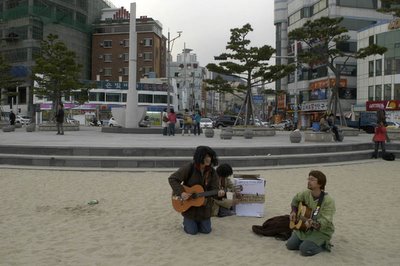
Valient protestors at Gwangali sharing their two cents with a couple of guitars and a wig of dreadlocks.
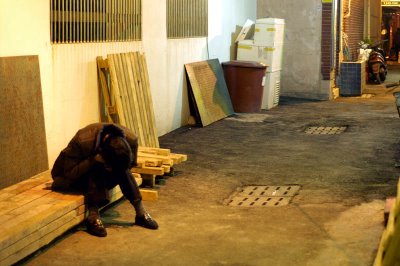
Soju sadness in Nampo-dong.
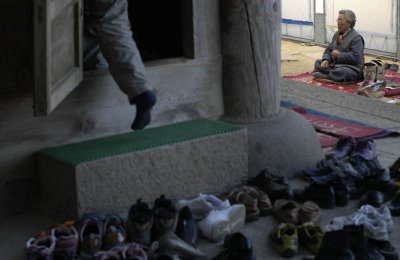
A scene from Beomosa. Be sure to take off your shoes before entering the temple...
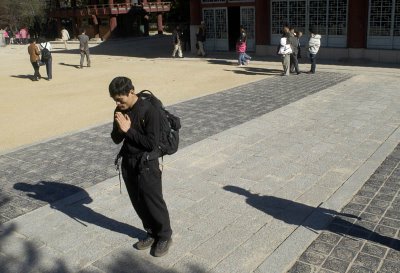
...And bow before you leave.
I have almost no notes from the last week. As I sit at my (now kind of working) computer and type out this blog, I find page after frustrating page of nothing but ‘to do’ lists, shopping lists and random bits of hangul scribbled here and there. When explaining what I’m trying to find to a Korean, the notepad makes for an exceptional tool. I only have one entry for the Korean Files.
'Fruit Virus' --Kinda like the happy virus, but tastier.
Gavin and I pushed into previously uncharted areas of the Nampo-dong market on our quest for simple household accouterments such as bath mats (our toilet leaks), charcoal air fresheners (our toilet stinks) and toilet paper (we’d like to be able to use our leaky, stinky toilet). By bus, train, and on foot we traversed the length and breadth of Busan, scouring the many stalls, shops and rebar carts for our quarry.
Man, I’m starting to feel heroic here. For one thing, we found a shower curtain store here in Nampo-dong. For 15,000 won we can now enjoy the luxury of a simple piece of plastic hanging on a bar. And guess what? Next door was a towel store! Like a latter-day Lewis and Clark, we charmed the natives into guiding us to each item on our list. We purchased trash cans, wall hangers, a mouse pad, power strips, air-fresheners, a bath mat, tea towels, water pitchers, food, toiletries and even discovered the elusive Nampo-dong Starbucks (actually, it was in plain sight. I just almost never go to that part of the district).
Gavin (yes, the new guy has a name now) was overwhelmed by the sheer number of shops, stalls, malls and vendors in the city. It didn’t make any sense to him at all.
“How do they all do enough business to pay the rent?” he asked repeatedly as we walked away the hours down endless streets of merchants and shoppers. Rare is the building that is not festooned with neon signs or blanketed with billboards, posters and business names from threshold to roof line. The top floors could be a motel, the middle floors a PC bong or restaurant, and the lower floors a doctor’s office. The vegetable vendors, gamerooms, dokpokki stands, fortune tellers and hair salons fend for themselves at the foot of the building or fill the alleyways branching off and vanishing deeper into the urban jungle. Some people are seemingly scraping together a living from nothing more than a naked piece of cardboard covered with vegetables and dead fish. No matter where you are, from Haeundae to Songdo, from the sleepy neighborhoods of Young-do to the bustling tourism centers of Seomyeon and PNU, it’s the same story.
Is there really enough business to sustain such a massive commercial presence? Do the residents of Busan really have that much buying power, or is the level of tourism substantial enough to offset the shortfall? For a city where the buildings rarely grow more than fifteen stories high, where is the money? Gavin had an interesting theory about at least one aspect of this conundrum: The subway.
The Busan subway stretches the length and width of the city, most of it underground. Measured in terms of ease of use, cleanliness and technology, the subway wins high marks in my book. The quiet metallic trains run on electricity provided by an overhead wires. They are smooth enough to allow a person to stand and fast enough to carry you the length of the city in under an hour, and following them like a ghost from station to station is a mall. Yes, I said a mall. The Lotte Underground Mall (my words).
A person could literally walk from Songdo to Haeundae - all underground - and if that person so desired, they could shop the whole way. Both sides of the trainless tunnel are lined with clothing, camera and knickknack shops staffed by bored (sometimes asleep and snoring) Korean clerks. It’s low ceilings and sickly florescent lights give the mall a clammy, claustrophobic character. Missing are the crowds of people that fill the streets of Nampo-dong. Only at the subway terminals do you find an appreciable number of people. Old men gather around the fountains, play go, get drunk and stare at the few people who walk past. Teenagers haunt the fastfood joints and bums sleep in the stairwells lit with daylight from the city above. The prices for goods sold in the Underground are much higher than their counterparts aboveground. To be perfectly honest, it feels a lot like a mall back home.
Why would anyone set up a business down here, I thought to myself. Perhaps to justify a bomb shelter, Gavin answered. This startling answer made logical sense: An underground chamber big enough to hold the entire city within reach of the entire city with it’s own water, food and transportation systems. Considering South Korea’s proximity to the jealous North and their strained relationship with Japan, a bomb shelter is probably not a bad idea.
Gavin, besides drawing fascinating conclusions about Busan’s infrastructure, completed his first week of teaching. Fearful of not being prepared to entertain a classroom full of children, Gavin spent every night fastidiously scouring books, inventing ideas, firing questions at me and drawing up lesson plans for his classes. I felt like an American Special Forces commander teaching the South Vietnamese how to fight the Communists.
Gavin, being better informed than I, sidestepped early problems such as the locating materials, finding lesson plans, and learning the names of the Korean teachers. He was also very strict with the students, a recipe for better behaved children down the line. Still, a few classes gave him trouble. Gavin noted how short their attention spans seemed to be and how little material the school provides for its teachers.
APEC, the Asian Pacific Economic Cooperation, was in session throughout the week. I was so preoccupied with building my nest and helping Gavin that I forgot all about it until Thursday night. As the bus taking us home crossed over the harbor into Young-do Gavin noticed crowds of people gathering along the bridge. Far off in the distance a magnificent fireworks display was lighting up the sky over Haeundae. I stared at it listlessly, too exhausted to follow my journalistic instincts any further than my imagination.
President Bush and Condoleeza Rice both made cameos at APEC. It was rumored that the Secret Service rented out every room in three of the biggest hotels in Haeundae to insure the President’s safety. The Chimpanzee in Chief used his two-day soapbox to demand that Asian countries open their doors wider for American goods and services. His speeches infuriated Koreans. There was footage of protests and riots in Haeundae on the local news.
I, for one, found the whole situation terribly ironic. The Korean government had spared no expense preparing for Bush’s visit. For the week of the APEC conference the streets of Haeundae bristled with heavily-armed soldiers and policemen. Great care was taken at the airports, seaports and in the subways to insure no villians entered the country, and Bush shows up and starts making demands of his gracious hosts as if they were nothing more than his servants. That’s gotta burn you. I wanted badly to put these thoughts on film and document the protests. I got my chance Friday.
APEC created so much chaos in Busan that Mr. Kim gave everyone Friday off. I used the free time as an excuse to take the subway out to Haeundae. At Gwangali I met a group of protesters with guitars and a cardboard box declaring APEC a tool of George W. Bush. One of them was dressed up in a rastafarian style complete with a dreadlocks wig covering his short black hair. They were suspicious of me, but allowed me to follow them to the beach where they played a few Bob Marley riffs translated into Korean.
Few people took the time to look up at the rebellious youths or listen to their anthems of protest. The beach was bare save for a few couples braving the biting wind to get a few moments alone by the sea, which was the same slate-blue as the sky. As the lights flickered to life on the Gwangali bridge, I took a walk down the beach.
I came across a knot of off-duty riot police standing by the shoreline getting drunk and staging bare chested wrestling matches despite the frigid weather. Many of them looked no older than the high school students in my Saturday classes. Their menacing black fatigues and square-billed caps lent them an air of hard-boiled authority belied by their smiling eyes and wirey physiques. An older man with a bottle of soju who I assumed to be their superior officer was mingling with his charges, joking and passing around his bottle of orange brew. Every now and then he’d cajole a couple of the boys into stripping off their shirts and jumping into a ring drawn in the sand for a contest. Bets would be placed, speeches made, and after everyone had said their piece or had their laugh, the boys would grapple until one or the other hit the sand first.

Gavin and I spent Sunday at Beomosa. The weather is truly cold now and the leaves are in full swing from green to gold. Even at 1 p.m. the sun was low and people’s shadows stretched far from their masters. We hiked up the mountain and ate kimbop in a grove of tall trees clinging to a forrest floor covered with boulders.
Well, that’s all I got for now. I have to get some sleep. Julie worked her last day Thursday and she’ll leave Tuesday. I’ll have photos from her going away ceremony on Monday. Peace. --Notes
1 comment:
(this is your godsister speaking...) stephen, i miss you! if you could, i'd love to have the pictures from edisto (with the shark and all) cause i don't think i got them! sadness.
well all is going well here, but i totally miss you. email me!
defygravity07@gmail.com
-Stephanie
Post a Comment